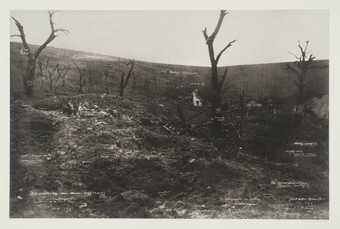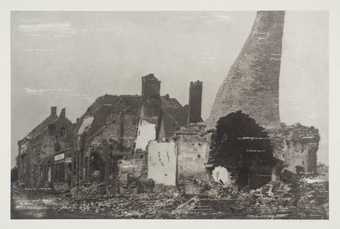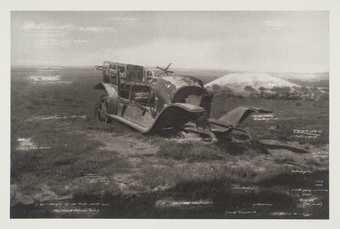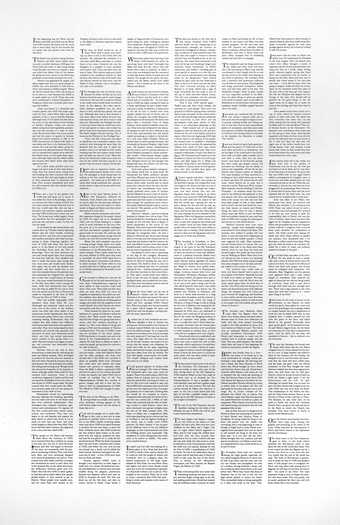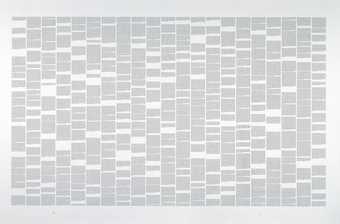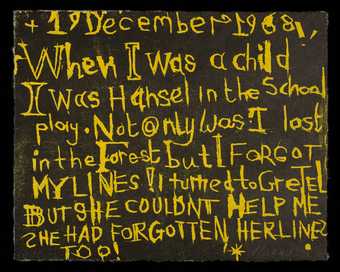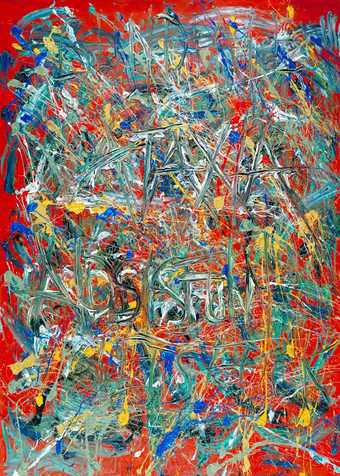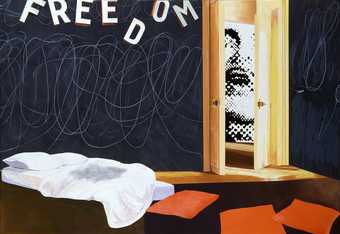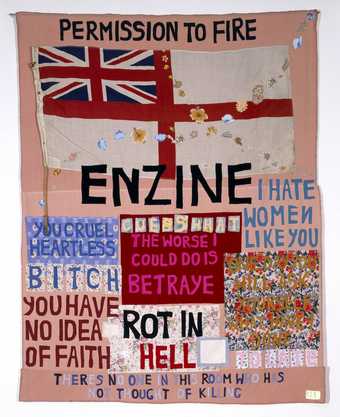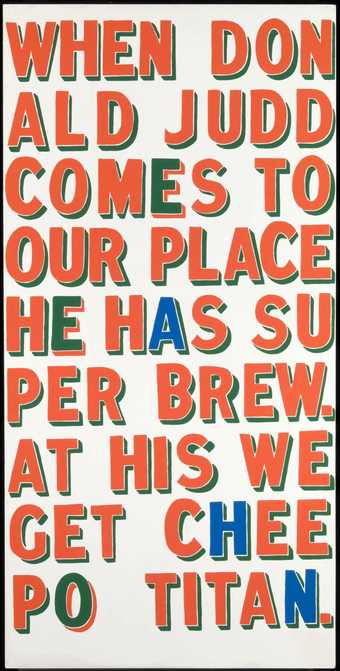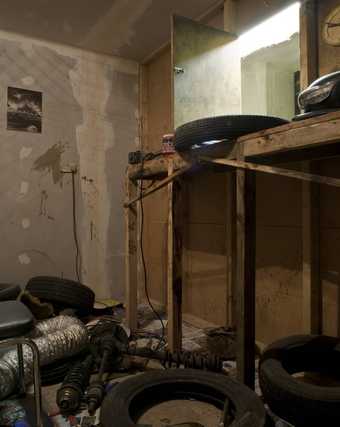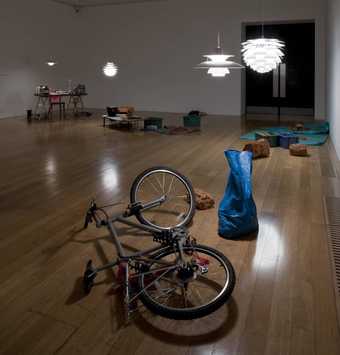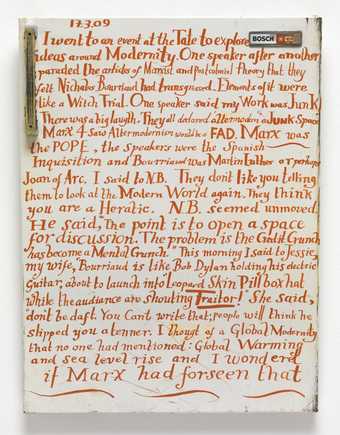
Not on display
- Artist
- Bob and Roberta Smith born 1963
- Medium
- Commercial paint on plywood
- Dimensions
- Support: 1537 × 1524 × 48 mm
- Collection
- Tate
- Acquisition
- Presented by Tate Patrons 2007
- Reference
- T12561
Summary
Make Art Not War is a large, square painting on two plywood panels that are attached together by five wooden battens on the reverse. Most of the painting is occupied by a four-word sentence – ‘MAKE ART NOT WAR’ – that runs over four lines in the centre of the composition. The first two words of this phrase are painted on the top panel against a background of Johnstone’s white gloss, while the second two are on the bottom board, backed by a layer of orange Dulux household paint. The large, bold letters are mostly painted in black and dark blue, but one is orange and another is white. All of the letters have outlines and simulated shadows.
This work was made by the British artist Bob and Roberta Smith in London in 1997. Smith originally found the plywood panels in a skip. Having attached them to the wooden battens, he gave them an undercoat of wood primer, before adding the other paints. The letters are executed using Signwriter’s Block, a typeface invented in the 1920s by a studio assistant of the British artist and designer Eric Gill (1882–1940). Smith produced individually cut paper stencils for the letters, placed the boards on a horizontal surface and then drew the characters onto them with a wax pencil. He then filled them with Bollom’s signwriting paint, using a long-handled, straight-headed Whistler Swan signwriting brush. Designed to be used quickly while painting up a ladder, Bollom’s paint is heavily pigmented and only requires a single coat. Consequently, the letters in this painting seem flat and opaque.
Smith claims that his father, a Second World War veteran and artist, was the original source of this work’s slogan-like statement. Smith has explained, ‘on his death bed he said to me, “Make art, not war. Don’t hate, draw”’(Smith 1997, p.2). The painting is one of a series of similar paintings which also feature humorous slogans advocating art over violence, such as Easels Not Guns 1997 and Paint Not Plastic Explosives 1997. These paintings were all shown together, alongside other groups of work, at Smith’s solo exhibition Don’t Hate Sculpt at Chisenhale Gallery in 1997.
The work’s simple graphic layout, as well as the paint that Smith used, draw upon the traditions of signwriting. However, while Smith would later adopt a skilled, freehand approach to painting letters, for this work he used the much easier technique of working with stencils. The simple, DIY nature of this approach is complemented by his use of cheap and discarded materials. Smith has stated that, for him, the act of turning rubbish into art encourages ‘the idea that the world can be organised differently. People can construct their own realities and worlds rather than living in MTV or BBC world’ (Bob and Roberta Smith, interview with Vivienne Gaskin, 1997, http://bak.spc.org/everything/e/hard/texts2/1patbrill.html, accessed 4 September 2014).
This interest in being able to construct one’s own reality is also emphasised by the fact that the artist’s very name – Bob and Roberta Smith – is actually the pseudonym of Patrick Brill. Brill claims that he devised this twofold artistic alter ego in order to create a more egalitarian platform for art making. Combining the name of his sister Roberta with two names which have historically been very common in the UK, ‘Bob’ and ‘Smith’, Brill playfully presents his works as the products of a purposefully ordinary male and female persona. This unusual move is also characteristic of Brill’s witty, irreverent approach to art. He has stated that the characteristics of his work – ‘like not to be a perfectionist ... and just getting the colours out of the tin – that seems to be somehow part of the humour I think’ (Smith 2008, p.6).
Further reading
Bob and Roberta Smith, Don’t Hate Sculpt, exhibition catalogue, Chisenhale Gallery, London 1997.
Bob and Roberta Smith, interview with Patricia Smithen and Andrew Wilson, 3 March 2008, Tate Conservation file, pp.1–14.
Bob and Roberta Smith, I Should be in Charge, London 2011, reproduced p.68.
Judith Wilkinson
May 2014
Supported by Christie’s.
Does this text contain inaccurate information or language that you feel we should improve or change? We would like to hear from you.
Film and audio
Explore
- abstraction(8,615)
-
- non-representational(6,161)
-
- text(1,043)
- emotions and human qualities(5,345)
-
- creativity(1,349)
- humour(1,441)
- social comment(6,584)
-
- war(358)
You might like
-
Tacita Dean CBE Erinnerung aus dem Weltkrieg
2001 -
Tacita Dean CBE La Bataille d’Arras
2001 -
Tacita Dean CBE Götterdämmerung
2001 -
Emma Kay The Bible from Memory
1997 -
Emma Kay Worldview
1999 -
Bob and Roberta Smith I was Hansel in the school play
2008 -
Derek Jarman Ataxia - Aids is Fun
1993 -
Dexter Dalwood Situationist Apartment May ‘68
2001 -
Bridget Riley Evoë 3
2003 -
Tracey Emin Hate and Power Can be a Terrible Thing
2004 -
Bob and Roberta Smith When Donald Judd Comes to our Place...
1997 -
Nigel Cooke New Accursed Art Club
2007 -
Mike Nelson The Coral Reef
2000 -
Simon Starling Work Made-ready, Les Baux de Provence (Mountain Bike)
2001 -
Bob and Roberta Smith I Went To An Event At The Tate (from Off Voice Fly Tip - Part 7)
2009

